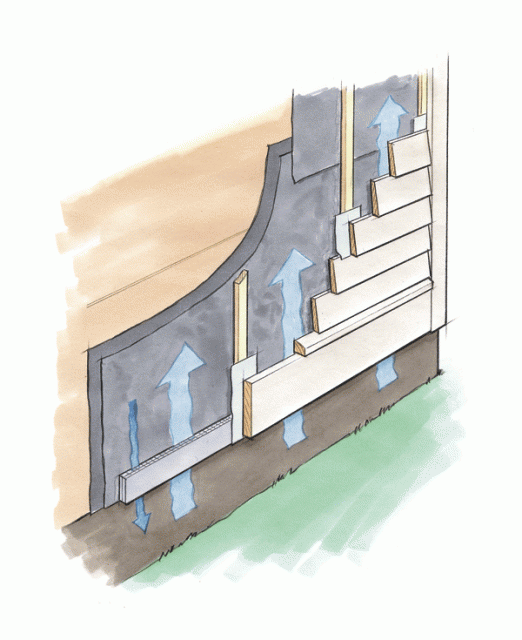ABOUT SIDING
Durable, low-maintenance siding is best
Durable siding requiring little maintenance is the appropriate choice for a green home.
Siding is an important architectural feature. There are half a dozen major families of siding, and many variations within those categories. Some are strong regional favorites, either because they are well suited to the climate or because they have a long local history (usually both).
In addition to durability, criteria for choosing siding include cost, maintenance requirements, ease of installation, and environmental impact.
ABOUT RAINSCREENS
Stopping rain that gets past the siding
Even the best cladding will fail if it is installed improperly. The performance of all of the materials listed above depends on the quality of installation, including the water-resistive barrier, flashing, and back-venting (or rainscreen) details that allow the siding to dry properly from the back. (For more information on WRBs, see All About Water-Resistive Barriers.)
In most cases, the investment in a rainscreen siding installation pays dividends in paint longevity and siding durability.
Vinyl siding is inherently well ventilated and always has air behind it. Brick veneer, if installed according to code requirements, always includes a ventilated air space between it and the sheathing. Neither vinyl siding nor masonry veneers needs a rainscreen.
Siding without a rainscreen
Other types of siding — wood clapboard, cedar shingles, fiber-cement — are often fastened tight to the sheathing with no intervening air space. Such installations can perform well, especially in a dry climate or on a wall that is protected by a wide roof overhang. But such installations are less forgiving than rainscreen installations, and often experience premature paint failure. If one or two things go wrong, walls without a rainscreen can trap moisture and begin to rot. For more information on what can go wrong if a wall is poorly detailed, see All About Wall Rot.
When stucco is installed on a wood-framed wall, a rainscreen is always recommended. For more information on stucco installation, see To Install Stucco Right, Include an Air Gap.
To create a rainscreen, first install a layer of asphalt felt or housewrap over the sheathing. The wrap must be carefully integrated with window and door flashing. For horizontal siding like wood clapboards or fiber-cement, an air space can be created by installing vertical strapping over each stud. A variety of materials can be used for strapping, including 1×3 lumber, rips of 1/4-inch plywood, or plastic battens.
For panel siding, cedar shingles, or stucco, create an air space with a three-dimensional plastic mat (for example, Cedar Breather) or a plastic dimple sheet.
For more information on rainscreen installations, see All About Rainscreens.











Replies
Real wood siding is an aesthetic some prefer, the cement board if purchased pre painted holds paint very well and is a good fire stop being that it is cement.
In the end, personal preference rules in all siding choices including low and high end vinyl.
Michelle,
I agree with A.J. The main advantage of a fiber-cement siding like HardiPlank is that the paint job will last longer. You should save money in the long run, because you won't have to repaint as frequently as you would if you choose real wood siding.
In either case -- real wood or fiber-cement -- your paint job will last even longer if you install it over a rainscreen gap. For more information on the rainscreen approach, see All About Rainscreens.
Finally, the GBA Encyclopedia includes an article that you may want to read: Siding Choices.
thank you very helpful information.